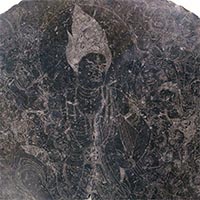Buddhist Art: Heian - Muromachi period
-

Plaque with Hairline Engraving of Zao Gongen (detail), Excavated from Kinpusen, Tenkawa-mura, Yoshino-gun, Nara, Heian period, dated 1001 (National Treasure, Lent by Nishiarai daishi Soujiji, Tokyo)
Japanese Gallery (Honkan) Room 3
May 19, 2015 (Tue) - June 28, 2015 (Sun)Buddhist art is one of the major genres that define Japanese art. Many masterworks date from the late Heian period, a time characterized as classical in Japanese art history. After the Kamakura period, Buddhist art further developed in its materials, methods, and styles as Zen schools and other new Buddhist schools emerged, together with the influence from the Chinese arts. This exhibit features artworks from the Heian to Kamakura periods, when Buddhist art most flourished, adding siginificant objects from the Nanbokucho and Muromachi periods.
Current exhibit includes:
Seated Amida Nyorai (Amitabha), Kamakura period, 12th-13th century (Lent by Ganshoji, Shizuoka)
Mandalas of the Two Realms, Kamakura period, 14th century
Descent of Amitabha, Kamakura period, 13th century (Important Cultural Property, Lent by Zenrinji, Kyoto)
Iconography of Daiitoku Myo-o (Yamantaka), Kamakura period, 13th century
Plaque with Hairline Engraving of Zao Gongen, Excavated from Kinpusen, Tenkawa-mura, Yoshino-gun, Nara, Heian period, dated 1001 (National Treasure, Lent by Nishiarai daishi Soujiji, Tokyo)
Daily Record of the Kujakuho Ritual for Rain, Kamakura period, dated 1191, Lent by Enpukuji, Chiba
Keman (Pendent ornament)Openwork design, Muromachi period, 15th century, Important Cultural Property, Lent by Jinshoji, Shiga
Keman (Buddhist ornamental pendant), Kamakura period, 13th century (Important Cultural Property, Lent by Nara National Museum, Nara)
